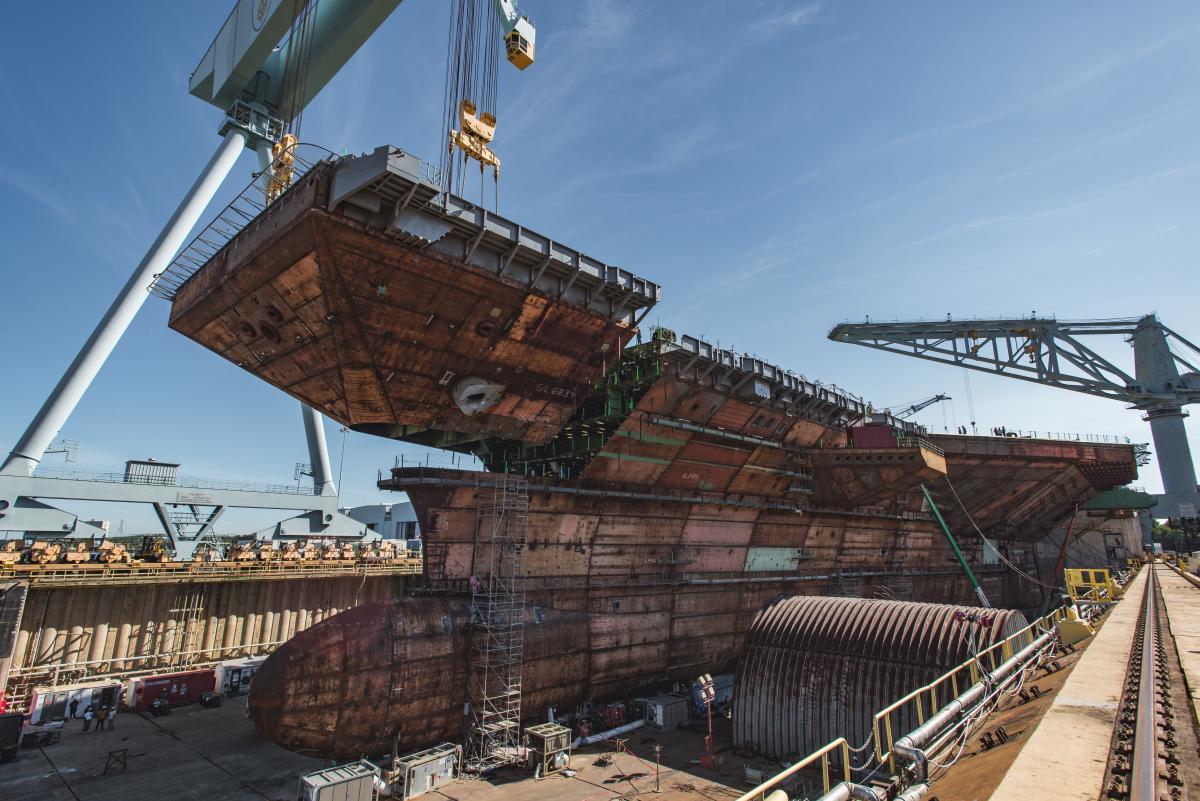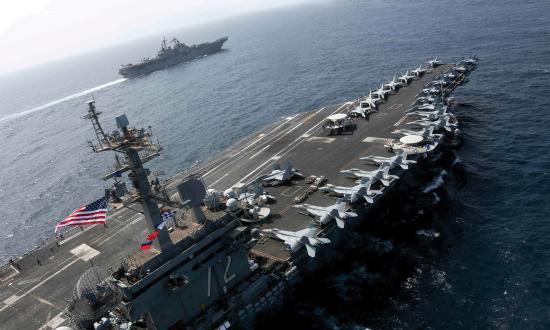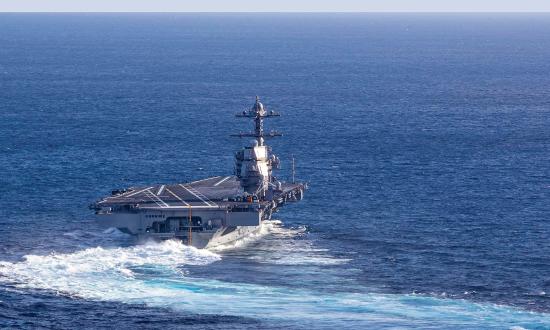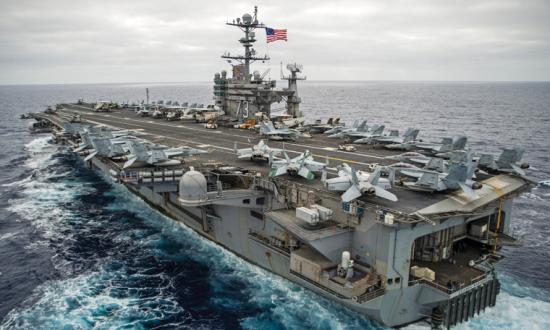The USS Gerald R. Ford (CVN-78), a challengingly complex, first-in-class U.S. Navy warship, had a busy 2020, which culminated with its first-ever large-scale integrated air wing operations.
During those operations, in November 2020, Rear Admiral Craig Clapperton, Commander, Carrier Strike Group 12, spoke to news media embarked on the ship. He talked about the ship’s enhanced capability for the crew to build weapons packages below deck and transport them rapidly to the flight deck. According to Clapperton: “We can move more weapons in a safer way, a faster way to a flight deck that is larger and more flexible. And that all contributes to the kind of agility, lethality, and flexibility the Ford brings to the fight.”
The Navy and the aircraft-carrier industrial base should be proud of these accomplishments, when the entire team’s mettle was tested by the global pandemic. The team proved resilient and strong as it adapted and delivered during these challenging times.
As the aircraft carrier industrial base continues to perform in the face of COVID-19, it has been reassured by the support offered by senior Navy leaders. In his memo to the shipbuilding industry in November, James Geurts, then–Assistant Secretary of the Navy for Research, Development, and Acquisition—wrote of the pandemic: “The Department of the Navy is only as strong as the women and men operating in our shipyards around the country and the world to keep our forces equipped and ready.” He noted, “If America could see what I have witnessed, they would be grateful for your [the industrial base’s] resiliency and productivity to keep the equipment flowing to our military’s deployed women and men.”
Procurement decisions over the past few years enabled the industrial base to overcome the potential unparalleled disruption to the industry. Two years ago, supported by Congress, the Navy awarded Huntington Ingalls Industries’ Newport News Shipbuilding a contract for two aircraft carriers of the Gerald R. Ford–class. Known as the two-ship buy, this contract was critical to the industrial base’s ability to produce amid the challenges of COVID-19.
As a result, supply-chain companies both have fulfilled the work orders and sustained work generated by this contract throughout the past year. This two-ship procurement not only gave the industrial base a predictable and stable plan to maintain a strong workforce and invest in infrastructure, it also drove down cost for ship construction.
But there are many underlying challenges on the horizon. According to the Center for Strategic and Budgetary Assessments, more than 20,000 companies in industries supporting shipbuilders have closed or shuttered naval shipbuilding activities since 2000. This has left many critical components in the supply chain reliant on a precious few, or, in many cases, a single domestic supplier (e.g., critical fuel-transfer and fire-fighting system pumps) or even foreign sources to construct the high quality and complex components needed for Navy warships. The current pandemic and emerging threats place the United States in a position where it cannot afford to shrink its defense industry any further. Against this challenging backdrop are calls to increase the size of the fleet in the era of great power competition.
As the mid-point of 2021 approaches, the nation’s leaders have an opportunity to keep the industrial base viable for decades by providing predictable shipbuilding plans from the Department of Defense, supported by continued strong investments by Congress, which will promote growth in the capability and the capacity of the shipbuilding enterprise.
Maintaining the industrial base to build the cutting-edge ships of the future starts with adequately funding aircraft carrier construction and maintenance projects on-time—without disruptors such as continuing resolutions and delayed appropriations. In addition, the industrial base benefits from a continued commitment from Congress, the Pentagon, and the Navy, preferably codified in legislation, to build up the force levels contained in the Navy’s 30-year shipbuilding plan. These actions would allow the shipbuilding industry to plan and invest in new equipment and technology, while retaining, hiring, and training a workforce capable of designing and building ships that evolve with the national defense strategy.
Leaders should continue to seek procurement strategies that deliver the highest quality product to warfighters, at the best value to the government, and at the best price for the taxpayers. As we have seen with the two-ship buy, and other programs’ multiyear procurements and block buys, these strategies maximize the material procurement savings benefit through “economic order quantity” procurement of material and supplies, improve industrial base stability and efficiency, and provide labor stability and associated efficiencies.
Congress and the Navy should consider expanding the period of time for advance procurement funding periods, which would unlock more stability in the procurement chain for long-lead type material and other high-volume material needs. A longer advance procurement period would provide more flexibility for program managers to work with industry to develop plans to lower risk and produce the necessary components in more efficient and cost-effective manners.
Recent defense authorization and appropriations bills have contained significant funds for supplier development supporting both Columbia-class ballistic-missile submarines and Arleigh Burke–class guided-missile destroyers. Broadening such investments to other programs would better serve the Navy by supporting more domestic suppliers, spurring growth in the manufacturing base, on-shoring critical components, and helping to identify and correct other critical constraints that impact ship-building operations.
In addition to these smart procurement approaches, there are concrete steps the Pentagon and Navy should take to sustain and expand the critical supply-chain companies who support carrier construction and other shipbuilding programs.
To start, improve commonality of design across shipbuilding programs. Economies of scale, reduced logistics footprint, and lower sustainment costs should remain critical focus points for Navy leaders during milestone and program reviews. In addition, find ways to use more commercial-off-the-shelf components in the design of noncritical systems to open opportunities for far greater numbers of suppliers to join the shipbuilding enterprise, expand competition, and bring down cost. While many shipboard systems will require noncommercial specifications, there should be a rigorous review of such barriers to ensure they are absolutely necessary for shipboard operations.
Last, restore, on-shore, and sustain a robust vendor base for shipbuilding. This is critically important to national security. In some circumstances, it could be more important than the one-time savings found in winner-take-all contracts for classes of warships with 50-plus-year expected service lives. Consider using multiple-award contracts, coupling construction and spare requirements, and aggressive funding strategies that can address areas where supply-chain competition could help add vendors to the CVN supply chain. As with every critical buying decision, all aspects of the purchase must be taken into consideration to ensure a robust domestic supply chain exists to support our national security requirements.
“Cutting-edge capabilities,” “built for future capacity,” “designed for 50-years of innovative warfighting”—all are phrases used to describe the Gerald R. Ford. But they are also phrases the nation must be able to use to describe the industrial base that builds and repairs its ships. Decisions and policies made this year will plot a course for the industrial base that will decide if these descriptions are attainable.
As the nation’s leaders plan the course for the future Navy, we urge them to review the lessons of 2020 and make decisions to enable the essential national security infrastructure of the aircraft-carrier industrial base to continue to build and maintain nuclear-powered aircraft carriers, the most-capable, modern-engineering marvels of the Navy fleet.






